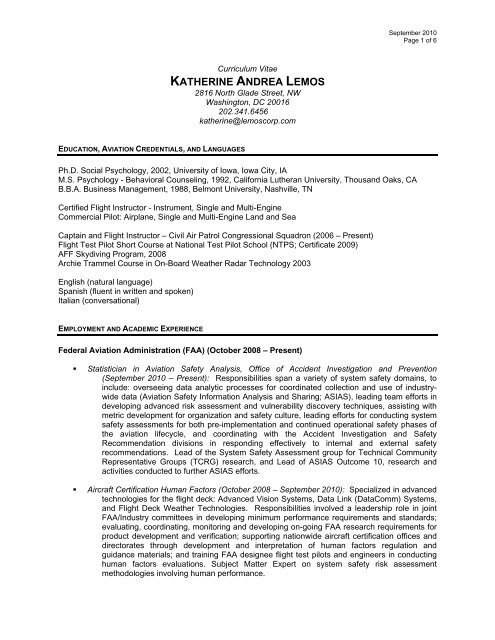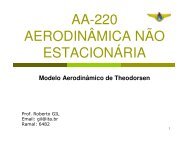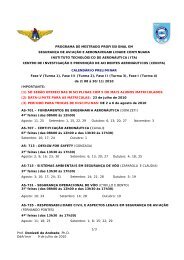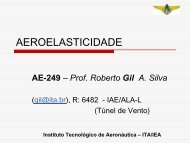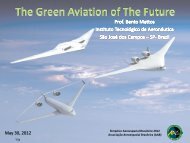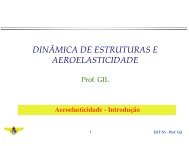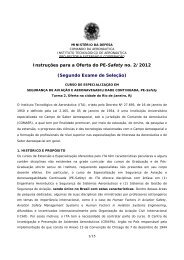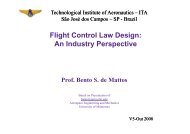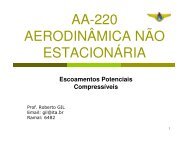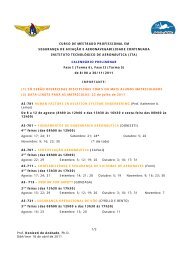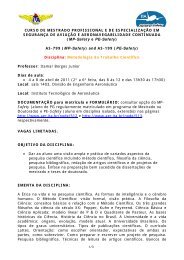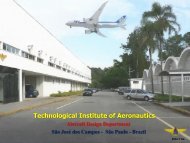KATHERINE ANDREA LEMOS - ITA
KATHERINE ANDREA LEMOS - ITA
KATHERINE ANDREA LEMOS - ITA
Create successful ePaper yourself
Turn your PDF publications into a flip-book with our unique Google optimized e-Paper software.
September 2010<br />
Page 1 of 6<br />
Curriculum Vitae<br />
<strong>KATHERINE</strong> <strong>ANDREA</strong> <strong>LEMOS</strong><br />
2816 North Glade Street, NW<br />
Washington, DC 20016<br />
202.341.6456<br />
katherine@lemoscorp.com<br />
EDUCATION, AVIATION CREDENTIALS, AND LANGUAGES<br />
Ph.D. Social Psychology, 2002, University of Iowa, Iowa City, IA<br />
M.S. Psychology - Behavioral Counseling, 1992, California Lutheran University, Thousand Oaks, CA<br />
B.B.A. Business Management, 1988, Belmont University, Nashville, TN<br />
Certified Flight Instructor - Instrument, Single and Multi-Engine<br />
Commercial Pilot: Airplane, Single and Multi-Engine Land and Sea<br />
Captain and Flight Instructor – Civil Air Patrol Congressional Squadron (2006 – Present)<br />
Flight Test Pilot Short Course at National Test Pilot School (NTPS; Certificate 2009)<br />
AFF Skydiving Program, 2008<br />
Archie Trammel Course in On-Board Weather Radar Technology 2003<br />
English (natural language)<br />
Spanish (fluent in written and spoken)<br />
Italian (conversational)<br />
EMPLOYMENT AND ACADEMIC EXPERIENCE<br />
Federal Aviation Administration (FAA) (October 2008 – Present)<br />
• Statistician in Aviation Safety Analysis, Office of Accident Investigation and Prevention<br />
(September 2010 – Present): Responsibilities span a variety of system safety domains, to<br />
include: overseeing data analytic processes for coordinated collection and use of industrywide<br />
data (Aviation Safety Information Analysis and Sharing; ASIAS), leading team efforts in<br />
developing advanced risk assessment and vulnerability discovery techniques, assisting with<br />
metric development for organization and safety culture, leading efforts for conducting system<br />
safety assessments for both pre-implementation and continued operational safety phases of<br />
the aviation lifecycle, and coordinating with the Accident Investigation and Safety<br />
Recommendation divisions in responding effectively to internal and external safety<br />
recommendations. Lead of the System Safety Assessment group for Technical Community<br />
Representative Groups (TCRG) research, and Lead of ASIAS Outcome 10, research and<br />
activities conducted to further ASIAS efforts.<br />
• Aircraft Certification Human Factors (October 2008 – September 2010): Specialized in advanced<br />
technologies for the flight deck: Advanced Vision Systems, Data Link (DataComm) Systems,<br />
and Flight Deck Weather Technologies. Responsibilities involved a leadership role in joint<br />
FAA/Industry committees in developing minimum performance requirements and standards;<br />
evaluating, coordinating, monitoring and developing on-going FAA research requirements for<br />
product development and verification; supporting nationwide aircraft certification offices and<br />
directorates through development and interpretation of human factors regulation and<br />
guidance materials; and training FAA designee flight test pilots and engineers in conducting<br />
human factors evaluations. Subject Matter Expert on system safety risk assessment<br />
methodologies involving human performance.
September 2010<br />
Page 2 of 6<br />
Instituto Tecnológico de Aeronáutica – <strong>ITA</strong>, São José dos Campos, SP, Brazil (2009 – Present)<br />
• Visiting Professor – Aviation Safety and Continued Airworthiness Professional Master &<br />
Specialization Courses: Student Advisor; course development and delivery of the following<br />
short courses: Human Factors in Aviation Safety and Aviation Safety Management Systems.<br />
National Institute of Aerospace – Consultant (2007 – Present)<br />
• NASA’s Langley Research Center, Aviation Safety and Aviation Airspace Systems Programs:<br />
Provides expertise as a consultant. Responsibilities include experiment design and analysis,<br />
survey design, database creation, reviewing and editing reports, and providing input on the<br />
role of human factors across a range of issues within the air transportation system.<br />
NASA’s NextGen Airportal Project: Research and analysis of today’s issues and constraints<br />
associated with operations from the gate to overhead flow integration, and identification of<br />
concepts and requirements addressing these issues and constraints. The outcome is a series<br />
of White Papers, technical research roadmaps, and research investment analysis framework.<br />
NASA’s support to the NextGen Joint Planning Development Office (JPDO) Safety Working<br />
Group: NASA’s support involves participation in the Safety Technical Analysis Team; safety<br />
issues collection, analysis and database creation; National Aviation Safety Strategic Plan<br />
Analysis and Documentation, and interacting with other JPDO working groups in their product<br />
development. Significant contributor to the National Aviation Safety Strategic Plan.<br />
National Transportation Safety Board (February 2005 – October 2008)<br />
• Senior Human Performance Investigator – Aviation Safety Division: Investigated the contributing<br />
role of human performance factors in aviation accidents for the purpose of providing safety<br />
recommendations to the aviation industry. Worked with Safety Analysis team in developing<br />
understanding of prevalence of accidents or incidents in development of recommendations.<br />
Presented findings and recommendations to the board for product approval with other<br />
members of the investigative team (Short list of accident investigations on following page).<br />
• Special Assistant to the Vice Chairman of the Board: Served 8-month detail as advisor to Vice<br />
Chairman Robert Sumwalt (2007 – 2008). Responsibilities included speech writing, notation<br />
review, preparation for briefings and board meetings across all transportation modes: rail,<br />
pipeline and hazardous materials, highway, marine and aviation. Special presentation topics<br />
included Runway Safety, Safety Management Systems and Pilot Professionalism.<br />
NASA’s Langley Research Center, Hampton, VA (2003 – 2005)<br />
Aviation Safety and Security Program (2003 – 2005)<br />
Visiting Assistant Professor - University of Maryland, Aerospace Engineering<br />
NASA Faculty Fellow - University of Iowa, Industrial and Mechanical Engineering<br />
• Principal and Co-Investigator: Managed interdisciplinary research teams in developing,<br />
conducting, analyzing and presenting human factors research for the design and<br />
development of next-generation weather displays for general aviation cockpits.<br />
NEXRAD Image Looping, Pilot Workload and Weather Situation Awareness<br />
Human performance assessment: Optimal radar looping characteristics<br />
Cooperative Research Agreement with Bendix/King – Honeywell Intl<br />
Correlation of Radar Reflectivity and Lightning (CoRRaL) Project<br />
Data acquisition and assessment: Ground-based versus on-board data<br />
Flight tests conducted at Kennedy Space Center, FL
September 2010<br />
Page 3 of 6<br />
University of Iowa, Dept of Industrial and Mechanical Engineering (2002 – 2004)<br />
• Co-Investigator, Project Development and Project Management: Managed interdisciplinary<br />
research teams in developing, conducting, analyzing and presenting human factors research<br />
for the design and development of next-generation synthetic vision displays for commercial<br />
aviation cockpits. (Received a NASA Group Achievement Award for the Aviation Safety SVS<br />
Project in both 2003 and 2004).<br />
Synthetic Vision Systems – Optimal Display Characteristics<br />
Human performance assessment: Optimal display resolution and field-of-view<br />
NASA LaRC Research Grant<br />
Synthetic Vision Systems – Terrain Density and Texture<br />
Human performance assessment: Optimal terrain density and texture<br />
Rockwell Collins Research Grant<br />
Scale development: Effectiveness of Crew Resource Management Training<br />
Constant Descent Approach Procedures: Workload and Performance<br />
Partnership with a major airline<br />
The University of Iowa, Dept of Psychology (1996 – 2002)<br />
• Dissertation: Statistics in context: Developed, conducted, analyzed and presented experiments to<br />
determine the influence of comparative statistical information on risk attitudes and behavior.<br />
• Lab Coordinator and Research Assistant: Trained and managed interdisciplinary research teams<br />
in developing, conducting, analyzing and presenting research for a variety of behavioral and<br />
social psychological topics, including risk perceptions and risk attitudes, social control and<br />
interaction, goal conflict and communication in dyads.<br />
• Teaching Assistant: Assisted in teaching both Introduction to Social Psychology and Experiment<br />
Design II for Cognitive Psychology courses.<br />
HUMAN PERFORMANCE GROUP CHAIRMAN FOR THE FOLLOWING ACCIDENT INVESTIGATIONS (NTSB) 1<br />
July 7, 2008, Kalitta Air, B-747-200, Bogota, Colombia (Multiple engine failure and impact with terrain)<br />
February 18, 2007, Shuttle America, ERJ-170, Cleveland, OH (Runway overrun/winter conditions)<br />
December 8, 2005, SWA, B-737-700, Chicago, IL (Runway overrun/winter conditions)<br />
September 6, 2005, Houston Helicopters, Sikorsky S-76A, Gulf of Mexico (Dual engine failure/ditching)<br />
August 19, 2005, NWA, 747-200 Guam (Gear-up landing)<br />
August 10, 2005, Copterline, Sikorsky S-76C++, Tallin, Estonia (Spatial disorientation/impact with water)<br />
May 10, 2005, NWA, DC-9/A-319, Minneapolis, MN (Runway incursion/hydraulic failure)<br />
March 23, 2004, ERA Helicopters, Sikorsky S-76A++, Gulf of Mexico (Controlled flight into water)<br />
1<br />
Involvement in Major or International accidents resulting in board products, as a full and active team member. Does not include<br />
participation in regional investigations or limited assistance in other major or international accidents. Public release of group<br />
chairman analytical reports is prohibited.
September 2010<br />
Page 4 of 6<br />
PUBLICATIONS<br />
Sumwalt, R., Lemos, K (2010). Accident Investigator’s Perspective. Crew Resource Management,<br />
Second Edition. Helmreich, R.L., Kanki, B.G, Anca, J. (Eds), Academic Press.<br />
Darr, S., Morello, S., Shay, R., Lemos, K. & Jacobson, R. (2009), A consideration of constraints on airport<br />
departure operations. National Aeronautics and Space Administration, Langley Research Center,<br />
June 2009. Report No: NASA/CR-2009-215763. NASA LaRC: Hampton, VA.<br />
Darr, S. Ricks, D. & Lemos, K. (2008). Safer Systems: A NextGen Aviation Safety Strategic Goal.<br />
Proceedings of the 27 th Digital Avionics Systems Conference, Minneapolis, MN.<br />
Martin, R., Johnsen, E. L., Bunde, J., Bellman, S. B., Rothrock, N. E., Weinrib, A., & Lemos, K. (2005).<br />
Gender differences in patients' attributions for myocardial infarction: Implications for adaptive health<br />
behaviors. International Journal of Behavioral Medicine, 12(1), 39-45.<br />
Lemos, K. & Chamberlain, J. (2004). In-flight weather trending information: Optimal looping<br />
characteristics for animated NEXRAD images. Proceedings of the 23 rd Digital Avionics Systems<br />
Conference, Salt Lake City, NV.<br />
Chamberlain, J. & Lemos, K. (2004). Design considerations for presenting data-linked animated radar<br />
imagery on in-flight displays. Proceedings of the 23 rd Digital Avionics Systems Conference, Salt Lake<br />
City, NV.<br />
Martin, R., Lemos, K., Rothrock, N., Bellman, B., Russell, D., Tripp-Reimer, T., Lounsbury, P. & Gordon,<br />
E. (2004). Gender disparities in common sense models of illness among myocardial infarction<br />
victims. Health Psychology, 23(4), 345-353.<br />
Keller, M., Lemos, K., Schnell, T, Parrish, R. & Glaab, L. (2003). Pilot performance as a function of<br />
display resolution and field of view in simulated flight using synthetic vision systems. Proceedings of<br />
the 22 nd Digital Avionics Systems Conference, Indianapolis, IN.<br />
Lemos, K., Schnell, T., Etherington, T., Vogl, T. & Postikov, A. (2003). Synthetic Vision Systems: Human<br />
performance assessment of the influence of terrain density and texture. Proceedings of the 22 nd<br />
Digital Avionics Systems Conference, Indianapolis, IN.<br />
Yang, S., Schnell, T. & Lemos, K. (2003). Spatial image content bandwidth requirements for synthetic<br />
vision displays. Proceedings of the 22 nd Digital Avionics Systems Conference, Indianapolis, IN.<br />
Schnell, T., Lemos, K., Keller, M., Yang, S. & Gutierrez, F. (2003). Synthetic Vision Systems: Optimal<br />
Display Characteristics. Technical report for NASA LaRC dated October 27, 2003, Operator<br />
Performance Laboratory, University of Iowa, Iowa City, IA.<br />
Jenson, M., Suls, J. & Lemos, K. (2003). A comparison of physical activity in men and women following<br />
hospitalization for CHD. Women and Health, 37(1), 31-48.<br />
Lemos, K., Suls, J., Jenson, M., Lounsbury, P. & Gordon, E.E.I. (2003). How do female and male cardiac<br />
patients and their spouses share responsibilities after discharge from the hospital Annals of<br />
Behavioral Medicine, 25(1), 8-15.<br />
Schnell, T. & Lemos, K. (2003). Synthetic Vision Systems: Terrain Density, Texture and Shading<br />
characteristics. Technical report (Deliverable 4.4.1.1) dated January 2003, Rockwell Collins, Cedar<br />
Rapids, IA.
September 2010<br />
Page 5 of 6<br />
Lemos, K., Schnell, T., Gordon, D. & Etherington, T. (2002). Bye-bye steam gages, welcome glass: A<br />
review of new display technology for general aviation aircraft. Proceedings of the 21 st Digital Avionics<br />
Systems Conference, Irvine, CA.<br />
Schnell, T. & Lemos, K. (2002). Synthetic Vision Systems: Terrain Density, Texture and Shading<br />
Characteristics. Technical report (Deliverable 4.2.2.1) dated September 2002, Rockwell Collins,<br />
Cedar Rapids, IA.<br />
Lemos, K. (2002). Statistics in context: The Influence of Comparison Information on Naïve Risk<br />
Perceptions. Dissertation Abstracts International: Section B: The Sciences & Engineering. Vol 63(4-<br />
B), Oct 2002, 2108, US: University Microfilms International.<br />
Suls, J., Lemos, K. & Stewart, L. (2002). Self-esteem, construal and comparisons of self versus friends<br />
and others. Journal of Personality and Social Psychology, 82(2), 252-261.<br />
Martin, R. & Lemos, K. (2002). From heart attacks to melanoma: Do common sense models of<br />
somatization influence symptom interpretation for female victims Health Psychology, 21(1), 25-32.<br />
Martin, R., Lemos, K., & Leventhal, H. (2001). The psychology of physical symptoms and illness<br />
behavior. In G. J. G. Asmundson, S. Taylor, & B. J. Cox (Eds.), Health anxiety: Clinical and research<br />
perspectives on hypochondriasis and related conditions, (pp. 22-45). Chichester, UK: Wiley.<br />
INVITED TALKS AND CONFERENCE PRESENTATIONS<br />
Lemos, K. Human Factors in Aircraft Certification, Federal Aviation Administration Recurrent Training for<br />
Designated Engineering Representatives; August, 2010. New York.<br />
Lemos, K. Human Factors in Aircraft Certification, Federal Aviation Administration Recurrent Training for<br />
Designated Engineering Representatives; March through August, 2009. Wichita, KS; Dallas, TX;<br />
Atlanta, GA; Boston, MA, Chicago, Ill.<br />
Darr, S. Ricks, D. & Lemos, K. Safer Systems: A NextGen Aviation Safety Strategic Goal. Proceedings of<br />
the 27 th Digital Avionics Systems Conference, October 2008, Minneapolis, MN.<br />
Lemos, K. & Chamberlain, J. In-flight weather trending information: Optimal looping characteristics for<br />
animated NEXRAD images. 23 rd Digital Avionics Systems Conf., October 2004, Salt Lake City, NV.<br />
Chamberlain, J. & Lemos, K. Design considerations for presenting data-linked animated radar imagery on<br />
in-flight displays. 23 rd Digital Avionics Systems Conference, October 2004, Salt Lake City, NV.<br />
Lemos, K. Statistics in Context: The Influence of Comparison Information on Naïve Risk Perceptions –<br />
Applications in the Aviation Domain. NASA Ames, October 23, 2003, San Jose, CA.<br />
Keller, M., Lemos, K., Schnell, T, Parrish, R. & Glaab, L. Pilot performance as a function of display<br />
resolution and field of view in simulated flight using synthetic vision systems. 22 nd Digital Avionics<br />
Systems Conference, October 2003, Indianapolis, IN.<br />
Lemos, K., Schnell, T., Etherington, T., Vogl, T. & Postikov, A. Synthetic Vision Systems: Human<br />
performance assessment of the influence of terrain density and texture. 22 nd Digital Avionics<br />
Systems Conference, October 15, 2003, Indianapolis, IN.<br />
Yang, S., Schnell, T. & Lemos, K. Spatial image content bandwidth requirements for synthetic vision<br />
displays. Monica Hughs (Chair), Synthetic Vision Systems Track, 22 nd Digital Avionics Systems<br />
Conference, October 15, 2003, Indianapolis, IN.
September 2010<br />
Page 6 of 6<br />
Schnell, T., Lemos, K., Keller, M., Yang, S. & Gutierrez, F. Synthetic Vision Systems: Optimal Display<br />
Characteristics. NASA LaRC, July 24, 2003, Hampton, VA.<br />
Lemos, K., Schnell, T., Gordon, D. & Etherington, T. Bye-bye steam gages, welcome glass: A review of<br />
new display technology for general aviation aircraft. Chamberlain, J. (Chair), General Aviation<br />
Technologies Track, 21 st Digital Avionics Systems Conference, October 29, 2002, Irvine, CA.<br />
Lemos, K., Effect sizes: Methods of calculating and reporting effect sizes in the social sciences.<br />
University of Iowa, Department of Psychology, March 16, 2001.<br />
Martin, R. & Lemos, K. Effects of stereotypes on symptom perception and illness behavior. Alex Rothman<br />
(Chair), Understanding the impact of stereotypes, discrimination, and prejudice on mental and<br />
physical health. Midwestern Psychological Association, May 4, 2000, Chicago, IL.<br />
Martin, R., & Lemos, K. Somatization stereotypes: Does information about sex and stress influence<br />
symptom interpretation University of Iowa, Department of Psychology. April 28,2000.<br />
Lemos, K., Jenson, M.E., Suls, J., Lounsbury, P. & Gordon, E.E.I. Adapting to cardiac disease: Male<br />
patients receive greater assistance from spouses than do female patients. Society of Behavioral<br />
Medicine, April 6, 2000, Nashville, TN.<br />
Lemos, K., Jenson, M.E., Suls, J., Lounsbury, P. & Gordon, E.E.I. Significance of attending cardiac<br />
rehabilitation: Symptom reporting in high risk patients. American Association of Cardiovascular<br />
Rehabilitation, September 18, 1999, Phoenix, AZ.


